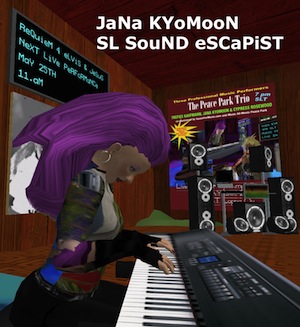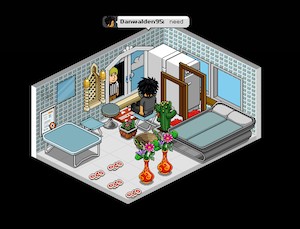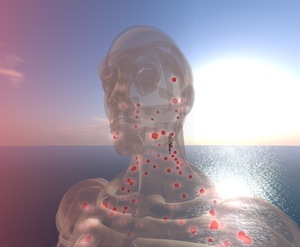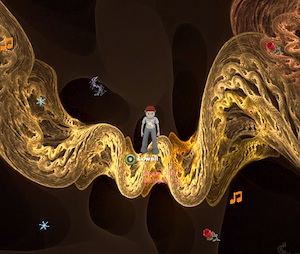1. The Guardian (UK) – Are online currencies striking gold? “Money. The stuff that makes the world go round. Every day we earn it, spend it, exchange it and lose it. But you won’t find any Linden dollars, Eve ISK or Facebook credits down the back of the couch. Virtual currencies like these are used for transactions in online worlds and social networking sites. While real-world currencies are on the slide, many virtual ones are going from strength to strength. In the second quarter of the year the equivalent of $144m (£91m) was traded on the LindeX, the official currency exchange of Second Life, where residents buy and sell Linden dollars for their US counterpart – a 20% increase on the previous quarter, while the US economy shrank by 1%. Trading activity increased by 6% in the last quarter of 2008.”
2. Financial Times (UK) – Trading in online virtual goods set to top $1bn. “Revenues from the sale of virtual goods will top $1bn this year in the US, according to analysts, a 100 per cent leap over last year that signals the arrival of a new online industry in the largest internet market in the western world. The findings, to be released in a report today, show that sales are expected to double again next year, with particularly fast growth noticeable in the social games category. Analysts and entrepreneurs have been following developments in virtual goods and social games closely. But the report will give the most complete picture to date of virtual goods sales trends in the US.”
3. VentureBeat (USA) – Electronic Arts exec says social gaming bubble resembles mobile games hype. “The social gaming bubble is getting bigger and it resembles all of the hype that used to envelop the mobile phone games and virtual world markets a few years ago. So says John Schappert, the newly appointed chief operating officer at Electronic Arts. When EA agreed to buy Jamdat Mobile for $680 million in December, 2005, that was a peak moment for the mobile games bubble. Venture capitalists funded lots of mobile game startups in the hopes of getting a similar outcome, only to see the peak shift to virtual worlds as Second Life.”
4. Signal Magazine (USA) – Virtual Design Challenge Opens To All. “A new competition is opening up the process of developing and improving virtual training environments by streamlining the rules and requirements for participation. The U.S. military spends billions of dollars developing and improving virtual environments to train its personnel, but this process can seem complex and difficult for individuals and firms without government contracting experience.”
5. Reuters – China Q2 online game revenues hit $906 mln -research firm. “Revenue from China’s online game market grew 39.5 percent in the second quarter from the previous year to 6.18 billion yuan ($906 million), according to data from research firm Analysys International on Tuesday. Tencent Holdings (0700.HK), which runs China’s largest online messaging platform and operates popular free-to-play games domestically, emerged as the market leader with 20.2 percent of the market and 1.24 billion yuan in revenues.”
6. Computerworld (USA) – Linden Lab CEO on Second Life’s growth, future. “While the recession has been brutal on most technology companies, one venture that has done relatively well is Linden Lab, the parent company of Second Life. When we first interviewed CEO Mark Kingdon in January, he said the company was profitable and growing. Last month, Linden Lab released figures showing increased usage of the virtual world, and a near doubling of the size of the in-world economy. The Standard recently caught up with Kingdon via email to see how the company’s enterprise push is faring.”
7. MTV.com (USA) – Project Natal May Provide Dance Controls, But ‘FaceAPI’ Could Let You Talk Or Make Out. “From what Microsoft has shown off so far, Project Natal looks like it will track various body movements for controls dealing with first-person shooters, sports games and maybe even lightsaber fights. PhD candidate Torben Sko, is concentrating on face movements in his work right now, though, and he says he’s found a way to track mouths, eyes and head movements nothing nothing more than a camera. “Using a program called ‘FaceAPI,’ it’s possible to track a person’s facial features using nothing more than a standard Web camera,” he explains in a video posted to TorbenSko.com. “In turn, we can use this information to drive the expression of a virtual character.”
8. Air and Business Travel News (UK) – Comparing real and virtual meetings. “In a bid to compare the virtual and real life, the UK and Ireland Institute of Travel and Meetings (ITM) and Eventia held two events, one a real meeting at the NEC in Birmingham, the other in the virtual reality computer programme Second Life. The same content was included in both events, held on September 22 and 23, after which the delegates were asked to complete a survey about their experience. The two meetings organisations wanted to use the events to test out the business viability of Second Life technology. After comparing the feedback, ITM and Eventia recently released the results of the experiment to be mixed.”
9. Sydney Morning Herald (Australia) – Teen net addicts at risk of mental health problems. “Obsessive use of the internet could create a mental-health epidemic, with up to 10 per cent of adolescents at risk, a Sydney academic warns. World studies have documented dangerous levels of “internet addiction” – computer use that interferes with daily lives – says Lawrence Lam, a behavioural epidemiologist at the University of Sydney and the Children’s Hospital at Westmead.”
10. World Politics Review (USA) – Social Media, Virtual Worlds and Public Diplomacy. “On Sept. 1, 2009, the new U.S. Ambassador to Kenya Michael E. Ranneberger, a career foreign service officer with deep experience on the African continent, started a Twitter feed. The seven or so tweets he posted between then and Sept. 29 were lauded as another example of “Twitter Diplomacy.” Shashank Bengali, blogging for McClatchy, declared that the ambassador came out “swinging” with highly charged comments about Kenyan presidential appointees and in support of Kenya’s need for reform.”
 JaNa KYoMooN, the avatar used by Jan Pulsford, is a musician I’ve known since the late 90s when we were both involved with online music collaboration via the now defunct
JaNa KYoMooN, the avatar used by Jan Pulsford, is a musician I’ve known since the late 90s when we were both involved with online music collaboration via the now defunct  JaNa: My fascination with music technology and computers started back in the days of the Oberheim System and continued through C-lab’s Notator on an Atari to working with Logic Audio on the Mac. I became a beta tester for Logic Audio’s Rocket Network, a global network of pioneers of on line collaboration and today I continue to develop that spirit in the 3D virtual world of Second Life where I perform as a solo virtual artist mixing electronica with ambient improvisations and rhythmic reflections.
JaNa: My fascination with music technology and computers started back in the days of the Oberheim System and continued through C-lab’s Notator on an Atari to working with Logic Audio on the Mac. I became a beta tester for Logic Audio’s Rocket Network, a global network of pioneers of on line collaboration and today I continue to develop that spirit in the 3D virtual world of Second Life where I perform as a solo virtual artist mixing electronica with ambient improvisations and rhythmic reflections.  JaNa: They come and go but so many to choose from! The Music ALL Music Peace Park of course! The Pyramid art gallery and Club Ethereal run by Torben Asp and Jess Oranos. The Bluff Arts Center with ZeroOne Paz, Gaia Island with Enchantress Sao, Anthology with Trella Mohan, Dragonfly Reign with Magnolia Anthony and Broody Flow, Firehouse with Trowser Boa and Sugar Hill Island with Marjorie Dibou. The list goes on . . . . and on
JaNa: They come and go but so many to choose from! The Music ALL Music Peace Park of course! The Pyramid art gallery and Club Ethereal run by Torben Asp and Jess Oranos. The Bluff Arts Center with ZeroOne Paz, Gaia Island with Enchantress Sao, Anthology with Trella Mohan, Dragonfly Reign with Magnolia Anthony and Broody Flow, Firehouse with Trowser Boa and Sugar Hill Island with Marjorie Dibou. The list goes on . . . . and on 1. Teen virtual world Habbo Hotel
1. Teen virtual world Habbo Hotel 
 Kyle: We had hoped the AWG group in SecondLife would mature as a basis for interop. Why not start with your most compatible world after all? But they are not keeping up with the speed of the Opensim dev’s with items like Hypergrid now linking any Opensim world. So since we cannot get hands on to help there on the SecondLife side we have decided to experiment with our own interop focusing on the access we now haveto the worlds core database store. We can get to the data now so anything becomes possible.
Kyle: We had hoped the AWG group in SecondLife would mature as a basis for interop. Why not start with your most compatible world after all? But they are not keeping up with the speed of the Opensim dev’s with items like Hypergrid now linking any Opensim world. So since we cannot get hands on to help there on the SecondLife side we have decided to experiment with our own interop focusing on the access we now haveto the worlds core database store. We can get to the data now so anything becomes possible. Roche Integrated Support Entourage Unique & Personal Our Mission, or
Roche Integrated Support Entourage Unique & Personal Our Mission, or  1. Metaplace are having a Halloween Party on the 31st October. All the details here.
1. Metaplace are having a Halloween Party on the 31st October. All the details here.
Recent Comments